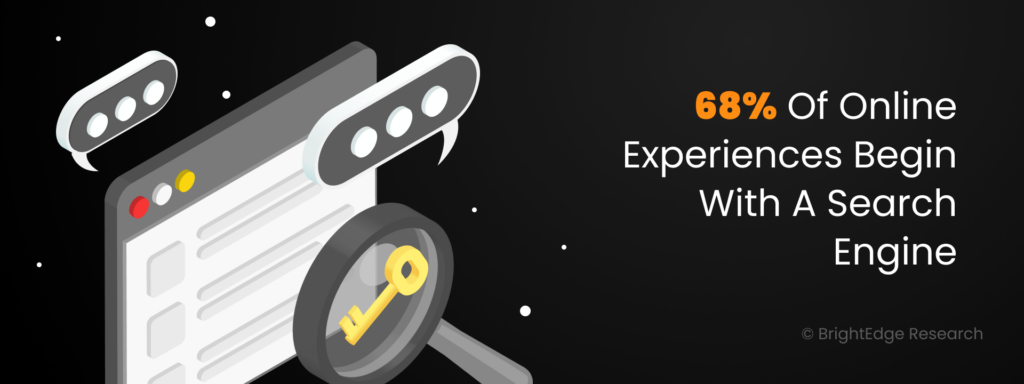SEO is the lifeblood of any successful online store. Just as a well-placed billboard in a bustling city drives foot traffic, strong SEO directly brings targeted, ready-to-buy customers to your website. But here’s the key difference: SEO is more than just getting found; it’s about making a lasting impression. We will explore the science of search algorithms, examine the psychology of online shopping, and offer actionable tips for immediate implementation.
Why is this connection between SEO optimization and conversions so crucial? Studies reveal that 68% of online experiences begin with a search engine, meaning potential customers are already primed and looking for solutions when they find your store. To turn interest into revenue, SEO must rank well, engage the right audience, and help them make confident purchasing decisions.

In this article, IT Delight eCommerce Development Company dives into proven SEO audit strategies that boost your store’s visibility and turn visitors into loyal customers. From targeted keyword strategies to on-page enhancements, these tips will help you refine your SEO to increase your income and grow your brand directly. Let’s take a closer look at how to create a conversion-focused SEO approach that keeps your business ahead of the competition.
What is SEO and How Does it Work?
Imagine your online store as a small island in a vast ocean. Your potential customers are ships searching for the perfect product. Those ships might sail past your island without a clear map or navigation system. SEO is like a lighthouse, guiding those ships directly to your shores.

What is SEO?
Search Engine Optimization (SEO) is the process of improving your website’s ranking in search engine results pages (SERPs). When someone types a question into Google, the search engine shows a list of the most relevant results. SEO helps ensure that your website is one of those top results.
How does SEO work?
Search engines use complex algorithms to determine which websites to rank highest. These algorithms consider a multitude of factors, including:
Relevance: Does your content match what people are searching for?
Authority: How trustworthy is your website?
User experience: How easy can users navigate and find information on your site?
Improving these areas can help your website rank higher in search results and attract more visitors.
Key benefits of SEO for eCommerce:
Increased visibility: More people will find your store.
Higher conversion rates: Organic traffic is more likely to convert into customers.
Improved brand authority: Higher rankings signal to users that you’re a reliable source.
Long-term, sustainable growth: SEO is an investment that pays off over time.
Why SEO is a game-changer for modern eCommerce?
Making SEO website audit means making a website more accessible for search engines like Google, Bing, and Yahoo to understand. This helps the website rank higher in search results. SEO focuses on three key areas: improving the website’s technical aspects, optimizing the content, and enhancing things that happen outside the website.
- Technical SEO ensures that your website is organized and quick to load. This helps search engines easily “crawl” and index your pages. Think of it as building a strong foundation for your store that is clean, efficient, and simple for search engines to navigate.
- Content SEO is about providing helpful and relevant content. Keyword research plays a key role here. Using keywords like “best car” or “affordable workout gear,” your site can match what users search for.
- Off-site SEO focuses on creating connections with respected websites through backlinks. This builds your site’s authority. Just like a business gets credibility from word-of-mouth, backlinks from trusted sites show search engines that your content is valuable.
Effective SEO in eCommerce is about engaging customers with relevant content. It aligns with their searches to build trust, improve user experience, and increase sales conversions.
Ready to turn clicks into customers?
Start optimizing your SEO today!
SEO and UX: A Winning Combination
Imagine you are hosting a party. You have sent out invitations, decorated your home, and made tasty food. When your guests arrive, they cannot find the front door, the music is too loud, and the food is cold. This is not the party you wanted, right? That’s often what happens when SEO and UX aren’t on the same team!
SEO Optimization aims to make your website rank higher in search results. This helps attract more visitors to your site. UX, or User Experience, focuses on designing a website that is easy to use and enjoyable to navigate. The goal is to keep visitors on your site and encourage them to take action, like purchasing or signing up for a newsletter.
At first glance, SEO and UX might seem like two separate things. But in reality, they’re very much intertwined. When you optimize your website for search engines, you’re also improving the user experience. And when you create a great user experience, you’re helping your website rank higher in search results.
Search engines aim to deliver the best possible results to users. One of the key factors they consider is how well a website meets users’ needs. A website offering a great user experience is more likely to keep users engaged, signaling search engines that the content is valuable.
Users are not interested in technical jargon; they simply want to find the information they need quickly and easily. A well-optimized website with a clear and concise layout, easy-to-read content, and fast loading times will likely keep users satisfied.
A positive user experience leads to higher conversion rates. When users enjoy their time on your website, they are more likely to take desired actions, such as making a purchase, signing up for a newsletter, or contacting you.

So, how can you improve both your SEO and UX?
- Conduct keyword research. This will help you understand what people are searching for and how you can create content that meets their needs.
- Optimize your website for mobile. More and more people are searching the web on their smartphones, so it’s important to ensure your website is mobile-friendly.
- Improve your website’s loading speed. A slow-loading website is a major turn-off for users.
- Use clear and concise language. Avoid jargon and technical terms that your users might not understand.
- Make your website easy to navigate. Use a clear and logical structure, making it easy for users to find what they want.
By focusing on both SEO and UX, you can create a website that attracts more visitors, keeps them engaged, and drives more conversions. It’s a win-win for both you and your users.
SEO and UX are two sides of the same coin. When you SEO optimize your website for search engines, you’re also improving the user experience. And when you create a great user experience, you’re helping your website rank higher in search results. SEO and UX can help you achieve your online goals by working together.
Local SEO and Its Role in Boosting Conversions
Imagine you own a cozy coffee shop in the heart of your city. Locals love it, but visitors often overlook it. Local SEO can help attract new customers by making your shop visible in searches for “coffee near me.” This increases your visibility and drives more business.

Local SEO Drives Targeted Traffic
Local SEO works by making your business more visible to people in your area who are actively searching for what you offer. If someone searches for “best coffee near me,” optimized local SEO will bring your place directly to their attention. Local SEO captures these high-intent users right when they’re ready to convert.
Google My Business (GMB) Boosts Credibility and Engagement
Google My Business allows businesses to manage their online presence, showcasing information like hours, location, reviews, and photos. An optimized GMB profile is essential for showing up in Google’s Local Pack—the map results shown above regular search results.
Positive Reviews Drive Decisions
Customer reviews are a form of social proof that heavily influences purchasing decisions. Potential customers rely on reviews as an indicator of quality, especially for local services and products.
Of course, people are more likely to choose a highly rated business over one with little to no reviews, directly impacting conversion rates.
Localized Content for Relevant Engagement
Creating location-specific content—like blog posts about local events or guides relevant to your area—helps your business appear in local search results. People are likelier to buy from a business they relate to and recognize.
SEO Conversion Checklist: Boost Your Online Store
- Focus on High-Intent Keywords: Use keywords that indicate purchase intent on product pages.
- Create Compelling Meta Titles and Descriptions: Incorporate enticing words like “exclusive” to drive clicks.
- Include a Clear Call to Action (CTA): Use phrases like “Get Yours Today!” at the end of meta descriptions.
- Leverage Structured Data: Implement schema for reviews, FAQs, and prices for enhanced search listings.
- Check Schema with Google’s Tool: Ensure your markup is error-free.
- Optimize for Mobile: Ensure your site is user-friendly on mobile devices.
- Use Google’s Mobile-Friendly Test: Identify and fix mobile usability issues.
- Prioritize Core Web Vitals: Keep your site fast and responsive.
- Personalize Content: Align content with specific keywords to engage visitors.
- Use High-Quality Visuals: Include professional images and videos of your products.
- Add Interactive Tools: Incorporate calculators or quizzes to boost engagement.
- Guide Users with Links: Direct traffic from blog posts to product pages.
- Balance SEO and UX: Ensure internal links are beneficial for both navigation and SEO.
- Optimize for Local Searches: Include location-specific terms on product pages.
- Showcase Reviews: Display customer testimonials for social proof.
- Encourage User-Generated Content: Request customer photos or videos to add authenticity.
- Build SEO-Friendly URLs: Keep URLs concise and keyword-focused.
- Create Logical Site Structure: Ensure all key pages are reachable within three clicks.
- Run A/B Tests: Experiment with different titles and CTAs for improvement.
- Analyze with Google Analytics: Track changes in traffic and conversions.
- Focus on Long-Form Content: Create comprehensive guides to retain high-intent visitors.
- Optimize for Returning Visitors: Use analytics to identify engaging content.
- Regular SEO Site Audit Backlinks: Remove harmful links and build quality ones.
- Write on Trends and Tips: Offer valuable, searchable content for user engagement.
- Keep Up with SEO Changes: Adjust strategies based on algorithm updates.
In conclusion, SEO is a powerful tool that helps not only to drive traffic but also to turn visitors into loyal customers. Focus on targeted keywords, improve your on-page elements, and connect SEO with user experience. Doing this can significantly increase your store’s conversions and overall revenue. Want to see how your site performs? Contact us for a complete site audit and discover what your online store can achieve!
